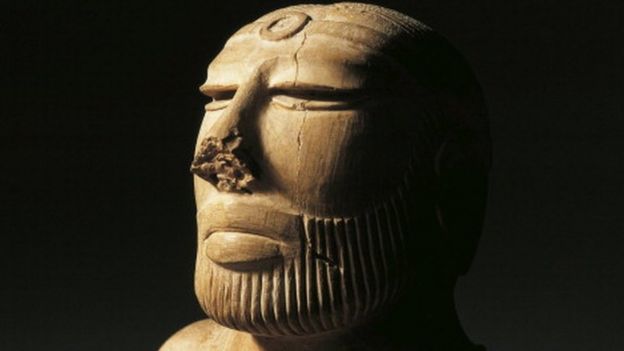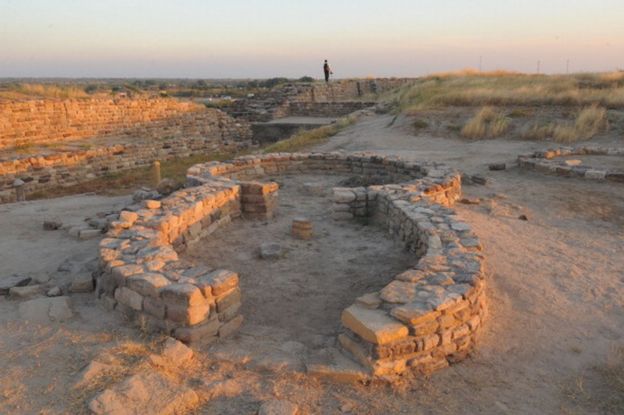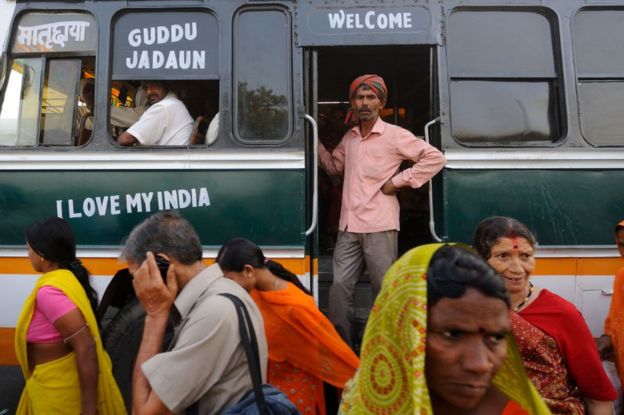How ancient DNA may rewrite prehistory in India
 The origin of Indians has been the subject of a heated debate
The origin of Indians has been the subject of a heated debate
New research using ancient DNA is rewriting prehistory in India - and shows that its civilisation is the result of multiple ancient migrations, writes Tony Joseph.
Who are the Indians? And where did they come from? In the last few years, the debate over these questions has become more and more heated.
Hindu right-wingers believe the source of Indian civilisation are people who called themselves Aryans - a nomadic tribe of horse-riding, cattle-rearing warriors and herders who composed Hinduism's oldest religious texts, the Vedas.
The Aryans, they argue, originated from India and then spread across large parts of Asia and Europe, helping set up the family of Indo-European languages that Europeans and Indians still speak today.
As it happens, many 19th Century European ethnographers and, of course, most famously, Adolf Hitler, also considered Aryans the master race who had conquered Europe, although the German leader considered them to be of Nordic lineage.
 The Harappan civilisation thrived in north-western India and Pakistan
The Harappan civilisation thrived in north-western India and Pakistan
When scholars use the term Aryan, it refers to a group of people who spoke Indo-European languages and called themselves Aryans. And that is how I have used it in this article. It does not refer to a race, as Hitler used it or as some in the Hindu right wing use it.
Many Indian scholars have questioned the "out of India" thesis, arguing that these Indo-European language speakers - or Aryans - were possibly just one of many streams of prehistoric migrants who arrived in India after the decline of an earlier civilisation. This was the Harappan (or Indus Valley) civilisation, which thrived in what is now north-western India and Pakistan around the same time as the Egyptians and Mesopotamians.
However, Hindu right-wingers believe the Harappan civilisation was also an Aryan or Vedic civilisation.
Tensions between the two groups backing these opposing theories have only increased in the last few years, especially since the Hindu nationalist Bharatiya Janata Party (BJP) came to power in India in 2014.
Into this long-running dispute has now stepped the relatively new discipline of population genetics, which has started using ancient DNA to figure out when people moved where.
Studies using ancient DNA have been rewriting prehistory all over the world in the last few years and in India, there has been one fascinating discovery after another.
The most recent study on this subject, led by geneticist David Reich of Harvard University, was published in March 2018 and co-authored by 92 scholars from all over the world - many of them leading names in disciplines as diverse as genetics, history, archaeology and anthropology.
Underneath its staid title - The Genomic Formation of South and Central Asia - lay some volcanic arguments.
 Dholavira in Gujarat state is one of the five largest Harappan sites
Dholavira in Gujarat state is one of the five largest Harappan sites
The study showed that there were two major migrations into India in the last 10,000 years.
The first one originated from the Zagros region in south-western Iran (which has the world's first evidence for goat domestication) and brought agriculturists, most likely herders, to India.
This would have been between 7,000 and 3,000BCE. These Zagrosian herders mixed with the earlier inhabitants of the subcontinent - the First Indians, descendants of the Out of Africa (OoA) migrants who had reached India around 65,000 years ago - and together, they went on to create the Harappan civilisation.
In the centuries after 2000 BCE came the second set of immigrants (the Aryans) from the Eurasian Steppe, probably from the region now known as Kazakhstan. They likely brought with them an early version of Sanskrit, mastery over horses and a range of new cultural practices such as sacrificial rituals, all of which formed the basis of early Hindu/Vedic culture. (A thousand years before, people from the Steppe had also moved into Europe, replacing and mixing with agriculturists there, spawning new cultures and spreading Indo-European languages).
Other genetic studies have brought to light more migrations into India, such as that of the speakers of Austro-Asiatic languages who came from south-eastern Asia.
 India's population is made up of a number of layers, according to the research
India's population is made up of a number of layers, according to the research
As I write in my book, the best way to understand the Indian population is to imagine it as a pizza, with the first Indians forming its base. Though the base of this rather irregular pizza is thin in some places and thick in others, it still serves as the support that the rest of the pizza is built upon because studies show that 50% to 65% of the genetic ancestry of Indians derives from the First Indians.
On top of the base comes the sauce that is spread over the pizza - the Harappans. And then come the toppings and the cheese - the Austro-Asiatic, Tibeto-Burman and Indo-European language speakers or Aryans, all of whom found their way into the subcontinent later.
To many in the Hindu right wing, these findings are unpalatable. They have been campaigning to change school curricula and remove any mention of Aryan immigration from textbooks. And on Twitter, several hugely popular right-wing "history" handles have long been attacking India's leading historians who have defended the theory of Aryan migrations and continue to do so.
For Hindu nationalists, there is a cost to admitting that the Aryans were not the first inhabitants of India and that the Harappan civilisation existed long before their arrival. It would mean acknowledging that Aryans or their Vedic culture were not the singular fountainhead of Indian civilisation and that its earliest sources lay elsewhere.
India's junior minister for human resource development, Satyapal Singh, was recently quoted in the media as saying: "Only Vedic education can nurture our children well and make them patriots who have mental discipline."
The idea of the mixing of different population groups is also unappealing to Hindu nationalists as they put a premium on racial purity. There is also the additional issue of the migration theory putting Aryans on the same footing as latter-day Muslim conquerors of India - such as the Mughals.
 Image copyrightGETTY IMAGES
Image copyrightGETTY IMAGES These are not just theoretical debates. The ruling BJP government in Haryana state, which neighbours the Indian capital Delhi, has demanded that the Harappan civilisation be renamed the Saraswati river civilisation. Since the Saraswati is an important river that is mentioned in the earliest of the four Vedic texts, such a renaming would serve to emphasise the link between the civilisation and the Aryans.
The new study puts an end to these debates and it has thus come as a shock to the Hindu right-wing. In a tweet attacking its co-author Prof Reich, ruling party MP and former Harvard University professor Subramanian Swamy said: "There are lies, damned lies and (Harvard's 'Third' Reich and Co's) statistics."
However, the real message that the new research carries is an exciting and hopeful one: that Indians have created a long-lasting civilisation from a variety of heredities and histories.
The genius of the Indian civilisation during its best periods has been inclusion, not exclusion. Unity in diversity is, indeed, the central theme of India's genetic make-up.
Tony Joseph is the author of Early Indians: The Story of Our Ancestors and Where We Came From, published by Juggernaut
